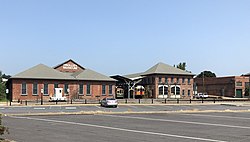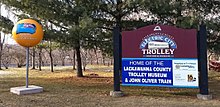
Moosic is a borough in Lackawanna County, Pennsylvania, United States, 3 miles (5 km) south of downtown Scranton and 10 miles (16 km) northeast of downtown Wilkes-Barre, on the Lackawanna River.

Scranton is a city in and the county seat of Lackawanna County, Pennsylvania, United States. With a population of 76,328 as of the 2020 U.S. census, Scranton is the largest city in Northeastern Pennsylvania and the Wyoming Valley metropolitan area, which has a population of 562,037 as of 2020. It is the sixth-largest city in Pennsylvania.
Lackawanna is the name of various places and later businesses in the mid-Atlantic United States, generally tracing their name in some manner from the Lackawanna River in Pennsylvania.

The Delaware, Lackawanna and Western Railroad, also known as the DL&W or Lackawanna Railroad, was a U.S. Class 1 railroad that connected Buffalo, New York, and Hoboken, New Jersey, and by ferry with New York City, a distance of 395 miles (636 km). The railroad was incorporated in Pennsylvania in 1853, and created primarily to provide a means of transport of anthracite coal from the Coal Region in Northeast Pennsylvania to large coal markets in New York City. The railroad gradually expanded both east and west, and eventually linked Buffalo with New York City.
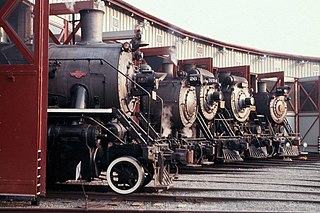
Steamtown National Historic Site (NHS) is a railroad museum and heritage railroad located on 62.48 acres (25.3 ha) in downtown Scranton, Pennsylvania, at the site of the former Scranton yards of the Delaware, Lackawanna and Western Railroad (DL&W). The museum is built around a working turntable and a roundhouse that are largely replications of the original DL&W facilities; the roundhouse, for example, was reconstructed from remnants of a 1932 structure. The site also features several original outbuildings dated between 1899 and 1902. All the buildings on the site are listed with the National Register of Historic Places as part of the Delaware, Lackawanna and Western Railroad Yard-Dickson Manufacturing Co. Site.

The Lackawanna & Wyoming Valley Railroad, more commonly known as the Laurel Line, was a Pennsylvania third rail electric interurban streetcar line which operated commuter train service from 1903 to 1952, and freight service until 1976. Its main line ran from Scranton to Wilkes-Barre.

The Delaware-Lackawanna Railroad is a shortline railroad operating in Northeastern Pennsylvania, especially the Scranton area.

Northeastern Pennsylvania (NEPA) is a region of the U.S. state of Pennsylvania that includes the Pocono Mountains, the Endless Mountains, and the industrial cities of Scranton, Wilkes-Barre, Pittston, Hazleton, Nanticoke, and Carbondale. A portion of this region is located in the New York City metropolitan area.

The Pennsylvania Trolley Museum is a museum in Washington, Pennsylvania, dedicated to the operation and preservation of streetcars and trolleys. The museum primarily contains historic trolleys from Pennsylvania, but its collection includes examples from nearby Toledo, New Orleans, and even an open-sided car from Brazil. Many have been painstakingly restored to operating condition. Other unique cars either awaiting restoration or that are incompatible with the 5' 2-1/2" Pennsylvania trolley gauge track are on display in a massive trolley display building. Notable examples of static display include a J.G. Brill “Brilliner” car, locomotives, and a horse car from the early days of Pittsburgh’s public transit systems.

The Pennsylvania Northeast Regional Railroad Authority (PNRRA) is a bi-county creation of both Lackawanna and Monroe counties to oversee the use of common rail freight lines in Northeastern Pennsylvania. The designated freight operator of the Pennsylvania Northeast Regional Rail Authority lines is the Delaware-Lackawanna Railroad and tourism operator is Steamtown National Historic Site.

The Harrison Avenue Bridge was a concrete deck arch bridge carrying Harrison Avenue in Scranton, Pennsylvania, United States.

The Bullet was a streamliner electric multiple-unit passenger car produced by the J. G. Brill Company in Philadelphia for the Philadelphia and Western Railroad (P&W) in 1931, and then similar, somewhat smaller single-unit, single-end versions were built for the Fonda, Johnstown and Gloversville Railroad in 1932. Few were sold because of the Great Depression and the public transport decline in the 1930s. However, some of the P&W cars ran for almost 60 years while later being under SEPTA.
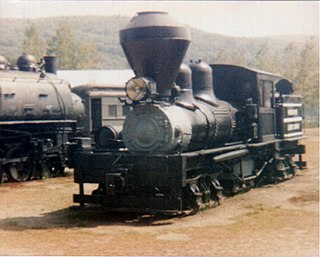
Steamtown, U.S.A., was a steam locomotive museum that ran steam excursions out of North Walpole, New Hampshire, and Bellows Falls, Vermont, from the 1960s to 1983. The museum was founded by millionaire seafood industrialist F. Nelson Blount. The non-profit Steamtown Foundation took over operations following his death in 1967. Because of Vermont's air quality regulations restricting steam excursions, declining visitor attendance, and disputes over the use of track, some pieces of the collection were relocated to Scranton, Pennsylvania in the mid-1980s and the rest were auctioned off. After the move, Steamtown continued to operate in Scranton but failed to attract the expected 200,000–400,000 visitors. Within two years the tourist attraction was facing bankruptcy, and more pieces of the collection were sold to pay off debt.
Lackawanna Transit Center is the main bus station and a proposed train station in Scranton, Pennsylvania, operated by the County of Lackawanna Transit System (COLTS).

The Erie Lackawanna MU Cars were a fleet of electric multiple unit commuter railcars used by the Delaware, Lackawanna and Western Railroad (D&LW) and successor railroads in the state of New Jersey. The D&LW undertook electrification of its Morristown Line and related branches in 1929–1930, and purchased 141 motor cars from Pullman to operate it. These were supplemented by 141 unpowered trailers of various types which were converted from existing rolling stock. The multiple units were successful and remained in service until 1984.
The Lackawanna Heritage Valley National and State Heritage Area is a state and federally designated National Heritage Area in northeastern Pennsylvania. It was initially established in 1991 as the first State Heritage Park in Pennsylvania, and was additionally designated a National Heritage Area in 2000. The designations recognize the area's heritage of industry, architecture, history and natural resources, and provide a framework for development and promotion of these features. The Lackawanna Heritage Valley National and State Heritage Area is managed by the Lackawanna Heritage Valley Authority, or LHVA.

The Scranton Railway Company built and operated electric trolleys in and around Scranton, Pennsylvania, from 1896 until 1954.
The Scranton, Montrose and Binghamton Railroad Company was an interurban railway, commonly referred to as the Northern Electric railway, which ran between downtown Scranton, Pennsylvania, and its suburbs to the northwest, including Clarks Summit, Dalton, Factoryville and Montrose.
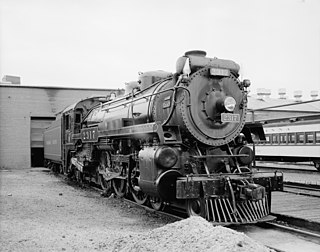
Canadian Pacific 2317 is a class "G-3c" 4-6-2 "Pacific" type steam locomotive built by the Montreal Locomotive Works for the Canadian Pacific Railway.
